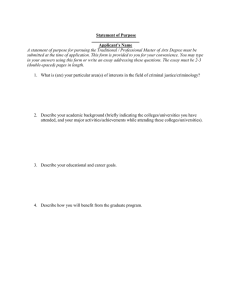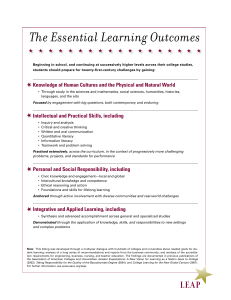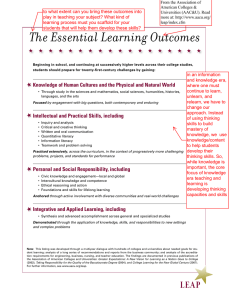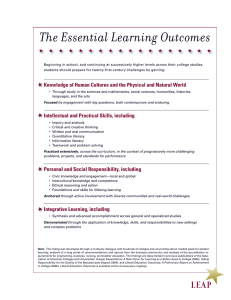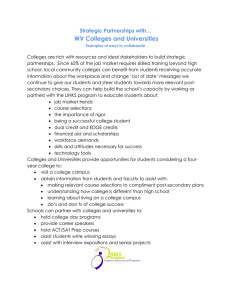What Faculty Can Do
advertisement
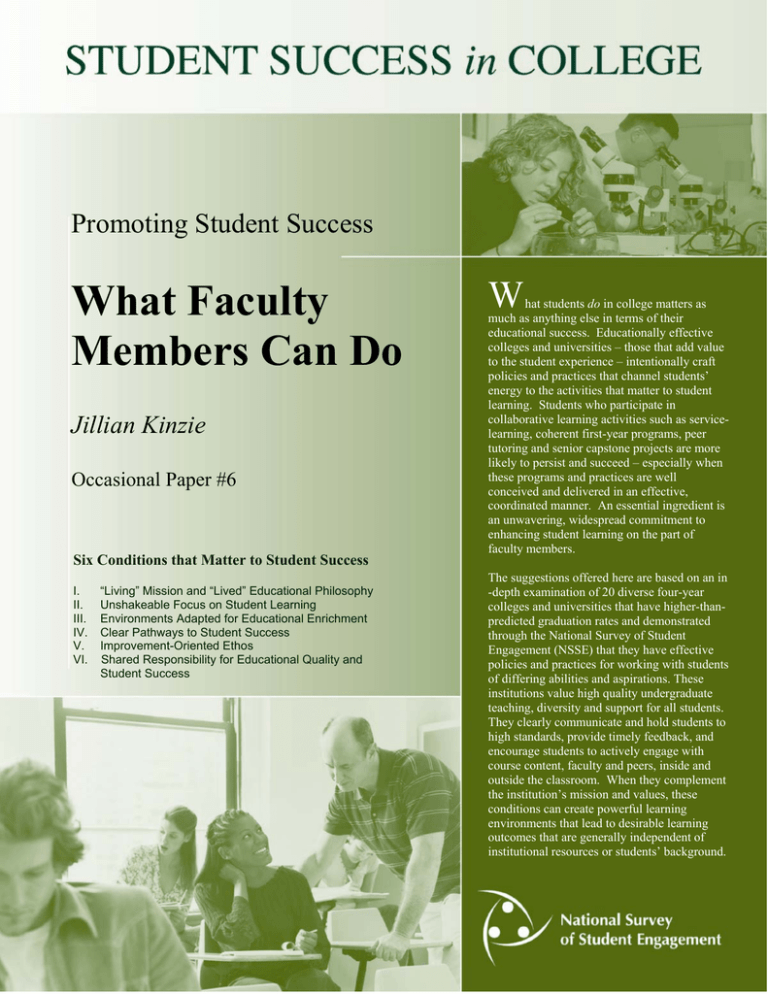
Promoting Student Success What Faculty Members Can Do Jillian Kinzie Occasional Paper #6 Six Conditions that Matter to Student Success I. II. III. IV. V. VI. “Living” Mission and “Lived” Educational Philosophy Unshakeable Focus on Student Learning Environments Adapted for Educational Enrichment Clear Pathways to Student Success Improvement-Oriented Ethos Shared Responsibility for Educational Quality and Student Success W hat students do in college matters as much as anything else in terms of their educational success. Educationally effective colleges and universities – those that add value to the student experience – intentionally craft policies and practices that channel students’ energy to the activities that matter to student learning. Students who participate in collaborative learning activities such as servicelearning, coherent first-year programs, peer tutoring and senior capstone projects are more likely to persist and succeed – especially when these programs and practices are well conceived and delivered in an effective, coordinated manner. An essential ingredient is an unwavering, widespread commitment to enhancing student learning on the part of faculty members. The suggestions offered here are based on an in -depth examination of 20 diverse four-year colleges and universities that have higher-thanpredicted graduation rates and demonstrated through the National Survey of Student Engagement (NSSE) that they have effective policies and practices for working with students of differing abilities and aspirations. These institutions value high quality undergraduate teaching, diversity and support for all students. They clearly communicate and hold students to high standards, provide timely feedback, and encourage students to actively engage with course content, faculty and peers, inside and outside the classroom. When they complement the institution’s mission and values, these conditions can create powerful learning environments that lead to desirable learning outcomes that are generally independent of institutional resources or students’ background. What Faculty Members Can Do 2 1. Embrace undergraduates and their learning 3. Clarify what students need to do to succeed Senior faculty members send strong messages to their colleagues and others when they teach lower division and introductory undergraduate courses and experiment with engaging pedagogies such as student-led seminars and group presentations, community-based projects, and applied learning. At the University of Michigan a set of named professorships, the Thernau Professors, were established to honor faculty with extraordinary achievements in undergraduate education. Another powerful statement about valuing undergraduate education is when faculty members adopt a talent development philosophy and use pedagogical approaches that address the learning needs of students who are less prepared to succeed. Faculty members at the University of Texas at El Paso believe that every student can learn under the right conditions. They use a variety of active and collaborative learning approaches, such as group projects and presentations, to engage students and have implemented course clustering – students enrolled in two or more of the same courses – to ensure that their mostly commuter population see some of their peers regularly, which also makes it easier for them to find times to study together. 2. Set and maintain high expectations for student performance Students will better manage academic challenges if they have an idea of what to expect and when and how to deal with these issues. Students benefit when their teachers provide examples of what successful students do that enables them to perform well in their courses or for a given learning activity; it is best when this information is offered at the beginning of a class or activity and when additional information, advice, and guidance is provided at key points later. If an activity or experience is critical to student success, for example, revising an assignment with a writing tutor, or participating in an internship, consider requiring it. Do not leave students – especially newcomers – to discover on their own what it takes to be successful. Become familiar with and promote the available academic and social support resources such as writing centers and tutoring support programs. Equally important, make others aware of students in difficulty so that timely interventions can be made. Faculty members teaching first year seminar courses at Winston-Salem State University serve as academic advisors and mentors to new students for the first academic year, and work with staff in the First Year College to connect students to academic support “Recognizing what students know services. and their perspectives, including asking for students’ opinions and taking their responses into account when making decisions,... go a long way to foster student engagement in learning.” Academic challenge does not simply mean piling on academic work. Rather, standards for achievement should be consistent with students’ academic preparation, and designed to stretch students to go beyond what they think they can accomplish. Appropriately calibrated to student ability, intensive reading and writing assignments accompanied by feedback are indispensable in helping students reach their potential, attain desired levels of performance, and recognize the value of spending time on academic work. Whether institutions have a writing across the curriculum requirement, or several writing intensive courses, or high expectations for writing in all disciplines, students are engaged at higher levels in their studies when writing is emphasized and they have adequate opportunities to revise their work based on feedback. Equally important, holding students to high standards is a source of both motivation and accomplishment when those standards are met. Fayetteville State University faculty members encourage students to see that success is within their reach, and support their achievement through welldeveloped programs like the First Year Initiative and the Early Alert System. Findings from the Faculty Survey of Student Engagement (FSSE) show that at institutions where faculty members have higher-than-average expectations for student engagement, students report being involved at higher levels in educational practices and report greater gains from their collegiate experience. 4. Use engaging pedagogical approaches appropriate for course objectives and students’ abilities and learning styles Students learn more when they are intensely involved in their education and have opportunities to think about and apply what they are learning in different settings. Students also benefit when they are engaged in the teaching and learning of their peers, such as through assigned group work, peer review, coordinated study groups, and peer teaching in-and out-of class. In addition, multiple styles of learning are accommodated by adopting varying teaching approaches. Because many students prefer concrete, practical applications, faculty members should provide opportunities for students to apply what they are learning to their lives outside the classroom. Service learning and community-based projects are good examples of structured approaches for application, reflection and connecting learning to real world issues. This approach to learning was particularly effective for students at both large, commuter institutions such as George Mason University, and small liberal arts colleges such as Macalester College, where faculty members and students connect with the local community through a variety of service-learning experiences. Opportunities for students to practice what they are learning, develop leadership skills, and work with people from different backgrounds, enriches student learning. Faculty members who take risks with their teaching, experiment with innovative pedagogical approaches, and make What Faculty Members Can Do teaching and learning a collaborative activity are more likely to foster student success. New and senior faculty members at Ursinus College benefit from weekly meetings to discuss teaching and effective pedagogical approaches. 5. Build on students’ knowledge, abilities and talents Students today are more diverse in virtually every way than their predecessors. We empower students when we respect and celebrate their backgrounds, prior achievements, and talents. Recognizing what students know and their perspectives, including asking for students’ opinions and taking their responses into account when making decisions, listening to students’ concerns, getting to know students individually, and thanking students for their input, go a long way to foster student engagement in learning. A key premise of California State University at Monterey Bay’s “assets” philosophy is that students’ prior knowledge and experiences should be used to foster learning in college. This pedagogical strategy, coupled with the institution’s interdisciplinary, problem-based curriculum, helps instill a sense of agency in students. Valuing students’ prior knowledge and experiences is a bridge to connecting students to the curriculum and to helping them make meaning of their undergraduate experience. Many faculty members design assignments that integrate adult students’ work and life experiences into the classrooms. Starting with what students know, or are good at, helps affirm students from historically underserved students who have doubts about their ability to do college level work. 6. Provide meaningful feedback to students Along with setting high standards, it is important to use various methods to assess students’ academic performance. Some institutions require students to complete rigorous written or oral comprehensive examinations. More importantly, timely, formative assessment and feedback are vital to helping students maximize their learning, especially when accompanied by clearly specified criteria that set forth descriptions of proficiency levels of performance. Alverno College is well-known for its integrated approach to assessment. Feedback comes from a variety of sources, including faculty, peers, and “external assessors” - community members trained to examine student work. Self assessment is also part of the learning experience at Alverno. Peer evaluation enhances students’ sense of responsibility to their study and or work group and selfassessment encourages students to reflect continually on the quality of their own effort and outcomes. When appropriately timed, constructive and encouraging feedback supports student learning, can motivate students to do their best, and helps to instill an ethic of continuous improvement. At the course level, feedback is especially 3 important in the early weeks so that students learn where they need to concentrate to perform at the expected level. 7. Weave diversity into the curriculum including out-of-class assignments Students benefit in several desirable ways from experiences with diversity. That is, those who report more exposure to diverse perspectives in their classes are also more likely to report higher levels of academic challenge, greater opportunities for active and collaborative learning, and a more supportive campus environment. They also learn valuable things about themselves and other cultures. For example, short-term cultural experiences sponsored by the University of Kansas and the University of Maine at Farmington are designed for students who cannot be away from work or family for extended periods of time might occur during spring break or include service learning opportunities. These trips offer valuable learning experiences for students who might not otherwise experience another culture. 8. Make time for students Maintaining an unwavering focus on student learning is labor-intensive. There is no substitute for human contact, whether face-to-face, or via e-mail. For this reason, faculty members must “make time” for students. Although serendipitous contact is more frequent at small residential colleges and universities, faculty members at large schools and those with commuter students also make time for students by being clear about the value of student-faculty interaction outside the classroom. For example, the University of Kansas requires student representation on institutional committees to increase the likelihood of student-faculty interaction. E-mail is also a viable approach to increase student-faculty contact. By collecting student e-mail addresses, sending messages about important campus events, and inviting students to submit early drafts of assignments via e-mail, faculty members can make time to interact with students in educationally meaningful ways. 9. Hold students accountable for taking their share of the responsibility for their learning As with other features of powerful learning environments, there are no shortcuts to excellence. Faculty members in cooperation with their colleagues in other academic units must organize academic programs in ways that demand substantial student commitment and accountability. Peer teaching and leadership help students hold one another accountable for learning. The preceptors in Wofford College’s learning communities take responsibility for designing and teaching and hold students to high standards. Department and program governance structures can be created that require student participation and leadership. Students learn about What Faculty Members Can Do 4 decision making and university issues through their participation in committees and campus governance. Students serving on the Educational Policy Committee at Wheaton College (MA) played an important role in creating and implementing a major curricular revision, working with student government to introduce the new curriculum to the study body and generate enthusiasm for its implementation. More importantly, being involved in meaningful ways with faculty members and peers helps connect students to the campus, thus increasing student satisfaction and the likelihood of persistence to graduation. Questions to Ponder: Although there is no blueprint for creating a student success-oriented institution, adapting these principles is likely to make a difference in terms of student learning. It is necessary to do things better and more frequently to promote student success. Here are some questions for faculty members: 1. In what ways do students’ backgrounds and talents influence teaching and learning in your course? 2. To what extent do faculty members experiment with engaging pedagogies and share what works with colleagues? 3. Do new students have adequate feedback about their academic performance and are they required to take advantage of writing centers, math and science tutorials, and technology support centers by the third week of class? 4. Do students hold their peers accountable for learning through peer evaluation, group projects, and study groups? Are they involved in meaningful ways with faculty members in university committees? Answers to these questions from different types of strong performing institutions around the country are offered in Student Success in College: Creating Conditions That Matter. The book features what 20 diverse, educationally effective college and universities do to promote student success. The Documenting Effective Educational Practice (DEEP) project was supported with generous grants from Lumina Foundation for Education and the Center of Inquiry in the Liberal Arts at Wabash College. Altogether, the 24-member research team talked with more than 2,700 people during its 40 multiple-day site visits to the DEEP schools. Six properties and conditions shared by these colleges and universities are discussed along with a wide array of effective educational policies and practices that if adapted appropriately can help a campus create and sustain a culture that supports student success. The book can be used in faculty and staff development, strategic planning, institutional mission clarification, leadership development, and collaborative efforts between academic and student affairs. A companion volume, Assessing Conditions for Student Success: An Inventory to Enhance Educational Effectiveness, will be available in September 2005 and provides a template for institutions to use to identify areas of institutional functioning that can be improved to promote student success. Sources: Kuh, G. D., Kinzie, J., Schuh, J. H., & Whitt, E. J. (in press). Assessing conditions to enhance educational effectiveness: The Inventory for Student Engagement and Success. San Francisco: Jossey-Bass. Kuh, G. D., Kinzie, J., Schuh, J. H., Whitt, E. J. & Associates (2005). Student success in college: Creating conditions that matter. San Francisco: Jossey-Bass. Jillian Kinzie is Associate Director of the NSSE Institute and the Indiana University Center for Postsecondary Research. For additional briefs visit NSSE Institute Project DEEP Related Papers, http://nsse.iub.edu/institute/ Cite as: Kinzie, J. (2005). Promoting student success: What faculty members can do (Occasional Paper No. 6). Bloomington, Indiana: Indiana University Center for Postsecondary Research. Project DEEP Colleges and Universities Alverno College (WI) California State University at Monterey Bay (CA) The Evergreen State College (WA) Fayetteville State University (NC) George Mason University (VA) Gonzaga University (WA) Longwood University (VA) Macalester College (MN) Miami University (OH) Sewanee: University of the South (TN) Sweet Briar College (VA) University of Kansas (KS) University of Maine at Farmington (ME) University of Michigan (MI) University of Texas at El Paso (TX) Ursinus College (PA) Wabash College (IN) Wheaton College (MA) Winston-Salem State University (NC) Wofford College (SC)


